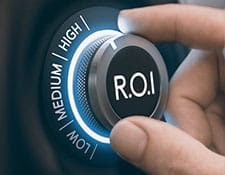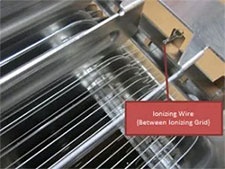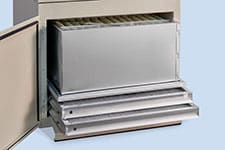Speak to an Air Purification Expert
Speak to an Air Purification Expert
Economic And Environmental Advantages Of Electronic Filtration For Coolant Mist
February 14th, 2024 | Posted in Air Cleaners

When specifying a machine tool coolant mist filtration system, the purchaser is confronted with the choice between an electronic filtration unit or a media filtration unit. Given that electronic units are generally a few hundred dollars more expensive the question often becomes, what does the buyer get for the extra money? The short answer is: Long-Term Savings. In order to justify that statement, a short description of the two coolant mist filtration technologies is in order.
For coolant mist, both media and electronic air filtration systems use impingers for collection of the coarse spray. In the impinger section, the spray droplets accumulate on the impinger mesh until they flow by gravity to bottom of the air cleaner and then back into the machine tool enclosure or into a receptacle. There’s no difference there. The difference is in how the air filtration system handles the fine mist generated by high pressure coolant and increased production rates.

Electronic units have two sections: a charging section and a collection section. In the charging section ionizer wires impart a positive charge to the mist particles in the air. The air with charged mist particles then passes through a secondary electric field where they are collected on a series of metal plates called “collector plates.” The cleaned air is then recirculated into the workplace. Depending on the air flow rate and the number of cells in the mist collectors, these units have a collection efficiency of 90% to 99%. Media units are also available with similar filtration efficiencies, so why buy an electronic unit that costs a few hundred more? (Learn more about how electronic units work to clean the air and how to troubleshoot them.)

One of the most compelling reasons is long term economy. Media units require periodic replacement because after a few months of service trapped oil, way lube and atmospheric dust tend to clog up the filter and the filter must be replaced. The actual cost of filter replacement will vary with the manufacturer of the air cleaner, but changing out the filters can run to a couple of hundred dollars per unit. Recommended filter change out schedules are typically in the range of a few months (about 3 or 4 times per year). If we say annual filter replacement costs are $800 per year, the resulting payback period associated with the initial higher cost of the electronic air cleaner is pretty short.

Another characteristic of media units is that the filters gradually become restrictive to air flow as they load up with contaminants. In order to maintain the required capture velocity, the media unit blower must work harder to move air through the partially clogged filter. The additional load on the blower will increase the amperage draw and consequent electrical utility costs of operating the media unit. By comparison, electronic filters maintain low energy requirements throughout their operating life.
It’s worth noting that in addition to the economic advantages provided by electronic units, there are environmental benefits achieved from not having to dispose of old filters every 3 months or so. One chief benefit is the abatement of landfill use.
Other advantages of electronic mist collectors include:
- Electronic units generate very little static pressure restriction, allowing a quieter fan with consequent reduction of the overall noise level in the shop.
- Electronic air cleaners are well-suited to the ultra-fine mist generated by high pressure coolant systems.
- Because the efficiency and general function of drainage from the collector plates, these electronic mist collectors are suitable for continuous operation.
- Since many of the available coolants are water miscible, electronic air cleaner cells are easily washed out with mild detergent and hot water rather than having to replace them.

